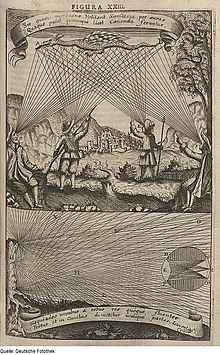Emission theory (vision)

Emission theory or extramission theory (variants: extromission) or extromissionism is the proposal that visual perception is accomplished by eye beams emitted by the eyes. This theory has been replaced by intromission theory (or intromissionism), which states that visual perception comes from something representative of the object (later established to be rays of light reflected from it) entering the eyes. Modern physics has confirmed that light is physically transmitted by photons from a light source, such as the sun, to visible objects, and finishing with the detector, such as a human eye or camera.
History[]
In the fifth century BC, Empedocles postulated that everything was composed of four elements; fire, air, earth, and water.[1] He believed that Aphrodite made the human eye out of the four elements and that she lit the fire in the eye which shone out from the eye, making sight possible.[2] If this were true, then one could see during the night just as well as during the day, so Empedocles postulated an interaction between rays from the eyes and rays from a source such as the sun.[citation needed]
Around 400 BC, emission theory was held by Plato.[2][3][4]
Around 300 BC, Euclid wrote Optics and Catoptrics, in which he studied the properties of sight. Euclid postulated that the visual ray emitted from the eye travelled in straight lines, and described the laws of reflection, and mathematically studied the appearance of objects by direct vision and by reflection.
Ptolemy (c. 2nd century) wrote Optics, a work marked the culmination of the ancient Greek optics, in which he developed theories of direct vision (optics proper), vision by reflection (catoptics), and, notably, vision by refraction (dioptrics).
Galen, also in the 2nd century, likewise endorsed the extramission theory (De Usu Partium Corporis Humani).[2] His theory contained anatomical and physiological details which could not be found in the works of mathematicians and philosophers. Due to this feature and his medical authority, his view held considerable influence in the pre-modern Middle East and Europe, especially among medical doctors in these regions.[5]
Evidence for the theory[]
Adherents of emission theory cited at least two lines of evidence for it.
The light from the eyes of some animals (such as cats, which modern science has determined have highly reflective eyes) could also be seen in "darkness". Adherents of intromission theory countered by saying that if emission theory were true, then someone with weak eyes should have his or her vision improved when someone with good eyes looks at the same objects.[6]
Some argue that Euclid's version of emission theory was purely metaphorical, highlighting mainly the geometrical relations between eyes and objects. The geometry of classical optics is equivalent no matter which direction light is considered to be moving in, since light is modeled by its path, not as a moving object. However, his theory of clarity of vision (the circular appearance of far rectangular objects) makes sense only if the ray emits from eyes.
Measuring the speed of light was one line of evidence that spelled the end of emission theory as anything other than a metaphor.
Refutation[]

Alhazen was the first person to explain that vision occurs when light bounces on an object and then is directed to one's eyes.[7]
Isaac Newton, John Locke, and others, in the 18th century, firmly held, by contrast, that vision was not only intromissionist or intromittist, but rays that proceeded from seen objects were composed of actual matter, or corpuscles, that entered the seer's mind by way of the eye.[8]
Persistence of the theory[]
Winer et al. (2002) have found evidence that as many as 50% of adults believe in emission theory.[9]
Relationship with echolocation[]
Sometimes, the emission theory is explained by analogy with echolocation and sonar. For example, in explaining Ptolemy's theory, a psychologist states:[10]
"Ptolemy’s ‘extramission’ theory of vision proposed scaling the angular size of objects using light rays that were emitted by the eyes and reflected back by objects. In practice some animals (bats, dolphins, whales, and even some birds and rodents) have evolved what is effectively an ‘extramission’ theory of audition to address this very concern. "
Note this account of the Ptolemaic theory ('bouncing back of visual ray') differs from ones found in other sources.[11]
References[]
- ^ DK frag. B17 (Simplicius of Cilicia, Physics, 157–159).
- ^ Jump up to: a b c Finger, Stanley (1994). Origins of neuroscience: a history of explorations into brain function. Oxford [Oxfordshire]: Oxford University Press. pp. 67–69. ISBN 978-0-19-506503-9. OCLC 27151391.
- ^ Arnold Reymond, History of the Sciences in Greco-Roman Antiquity, Methuen and Co., Ltd., 1927, p. 182.
- ^ Plato, Timaeus, sections 45b and 46b.
- ^ "A History of the Eye"
- ^ Doesschate, G. T. (1962). Oxford and the revival of optics in the thirteenth century. Vision Research, 1, 313-342.
- ^ Adamson, Peter (2016). Philosophy in the Islamic World: A History of Philosophy Without Any Gaps. Oxford University Press. p. 77. ISBN 978-0-19-957749-1.
- ^ Swenson, Rivka. (Spring/Summer 2010). Optics, Gender, and the Eighteenth-Century Gaze: Looking at Eliza Haywood’s Anti-Pamela. The Eighteenth Century: Theory and Interpretation, 51.1-2, 27-43.
- ^ Winer, G. A., Cottrell, J. E., Gregg, V., Fournier, J. S., & Bica, L. A. (2002). Fundamentally misunderstanding visual perception: Adults' beliefs in visual emissions. American Psychologist, 57, 417-424. [1].
- ^ Linton, P. (4 August 2018). "Do We See Scale?". bioRxiv 10.1101/371948.
- ^ Lindberg, D., Theories of Vision from Al-kindi to Kepler, University of Chicago Press (1976), pp.15-17, Smith, A. (2018). Greek Optics. In A. Jones & L. Taub (Eds.), The Cambridge History of Science (The Cambridge History of Science, pp. 413-427). Cambridge: Cambridge University Press, p.418
- Obsolete theories in physics
- Visual perception
- Optics